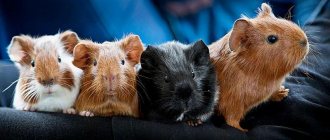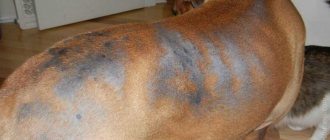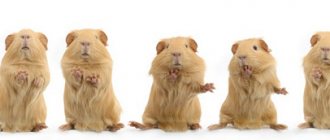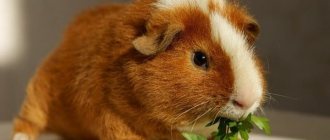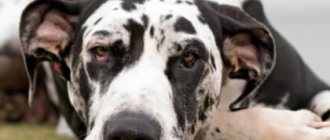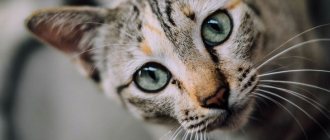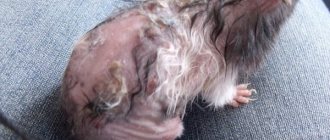Why does a guinea pig shed, what to do with severe and constant shedding?
Guinea pigs are one of the most beloved types of pets.
They don't need to be walked like dogs. They do not have an independent character like cats. Guinea pigs are less exotic and, therefore, more affordable animals than, for example, mini pigs.
This species of rodent is sociable and calm. The animals allow you to pick them up and stroke their fur. So, even the most inattentive owners immediately notice if a pet (especially long-haired pigs) begins to shed.
How does guinea pigs shed?
Typically, guinea pigs shed at the end of summer - early autumn and at the end of winter - early spring, and some all year round - this is due to the peculiarities of “out-of-the-way” apartment living.
If your furry pet eats well and properly, everything goes away without negative consequences. But it happens that this process is delayed and gives the animal unpleasant and even painful sensations.
To make shedding days easier, you need to include foods rich in vitamin C in your pet’s diet. You can also purchase special multivitamins for rodents at a pet store. And also do not forget to regularly ventilate the room where the rodent is kept (the higher the temperature in the room, the more actively the rodent “sheds its coat”).
It is imperative to feed the pig sprouted oats, herbs, fresh fruits and vegetables - apples, pears, bananas, tangerines, oranges, cucumbers, beets, carrots and cabbage. The latter, like peas, should be given in small quantities. If during the molting period the animal does not eat well, it is necessary to feed it vitamin C powder with glucose diluted in water.
To make the solution taste less sour, add a little sugar to it. This medicine should be given with a teaspoon several times a day and little by little so that the pet does not choke.
Why do guinea pigs shed?
It happens that guinea pigs' hair falls out during the molting period. This happens both due to a lack of vitamins and due to stress. Something could have scared the animal.
Sometimes even simply moving the cage from one room to another makes the rodent nervous. The only thing that will help here is peace and the absence of noises like loud music and screams throughout the house.
A more serious cause of hair loss is fleas or ticks. The main signs of this are that the animal often itches and runs around the cage in restlessness. To get rid of parasites, your pet's fur must be treated using special anti-parasite products or shampoo.
If the hair continues to fall out, seek veterinary attention.
Both on molting days and at any other time, you need to monitor the cleanliness of the animal’s bedding. In addition, it is recommended to brush short-haired guinea pigs with a soft brush at least a couple of times a month and always during the molting period. Long-haired rodents undergo this procedure twice a week, and daily during molting.
The tangles must be cut off with scissors. If you follow all these rules, your pet’s fur will be fluffy, soft and, most importantly, healthy.
Guinea pig grooming
Caring for guinea pigs involves a number of procedures, which includes caring for their fur. In some situations it is of an aesthetic nature, but most often it is necessary for rodents to maintain normal life functions.
When to trim animals
Guinea pigs with short fur do not necessarily require haircuts. But representatives of breeds with long and curly hair need it for the following reasons:
- High air temperature.
Guinea pigs do not tolerate heat well. Grooming your pet in the summer will prevent the development of heatstroke, overheating and poor health.
- The appearance of mats.
Long and soft wool can become very tangled in tangles and knots. You won't be able to comb them out, you just need to cut them. But after such a radical decision, a bald spot will appear. The best solution to prevent this situation is regular haircuts.
- Risk of falling.
Long hairs can get under the animal's paws while walking. The situation is dangerous with a high risk of falling and even injury.
Interesting! Guinea pigs' fur grows on average 2 cm per month.
Haircut is also recommended for nursing females. It will provide access to the nipples and make it easier for newborns. Older animals should have some of their fur cut off near the anus. This is associated with frequent indigestion.
An unpleasant reason for the procedure is the appearance of lice or fleas. In this case, the haircut is accompanied by treatment with anti-flea drugs.
There are many reasons for cutting hair at home. This procedure is especially recommended for Sheltie, Peruvian breed, Texel and other long-haired rodents. An exception is preparing guinea pigs for an exhibition. Before an important event, it is better to entrust this matter to professionals.
The first haircut occurs at 2 months for males and at 1.5 months for females. But the decisive role in this matter is played by the length of the coat and the intensity of its growth.
Carrying out the procedure
If the haircut is not related to visiting an exhibition, special tools will not be required for it. In this case, ordinary scissors or a shaving machine will do. Scissors will quickly cut hair on certain areas of the body or remove tangles. They also begin to accustom the animal to the procedure. The machine is convenient for quickly cutting the entire body. First, the hair is removed in the area of the belly and anus, and then in other areas.
Before the exhibition, the haircut is carried out in a pet salon. It is also better to entrust a shy or nervous guinea pig to professionals.
There are some recommendations for carrying out the procedure yourself:
- The animal needs to be cut every three months;
- Dirty and unkempt strands should be removed;
- It is better to perform the procedure by summer.
Types of haircuts
Several types of haircuts are popular in grooming salons:
- under the car - the best option for the summer;
- creative haircut – for lovers of uniqueness;
- formation of bangs;
- hair curler for long-haired breeds.
Important! Before starting a haircut, it is recommended to voice all your wishes to the hairdresser in detail. Also, the type of haircut will depend on the type and condition of the fur.
Trimming may be suggested for guinea pigs with thick coats. This procedure involves forced hair loss. Abroad, it takes place in pet salons. However, the simplicity of its implementation allows you to do forced molting at home.
Its technology is as follows:
- A small amount of wool is placed between the fingers. And then carefully stretches along the growth and against the growth of hairs
- The frequency of the procedure depends on the type of fur, the animal’s feeding habits, and the time of year.
Causes and treatment of hair loss in guinea pigs
Every animal owner is faced with the phenomenon of shedding. It is important to distinguish between natural hair loss and a symptom of disease. If the owner knows when guinea pigs shed and what causes this process, he will be able to take care of his pet and provide him with the necessary help. Please remember that the information offered is not a substitute for visiting a veterinarian who has the resources to make an accurate diagnosis.
Pododermatitis
Pododermatitis is a fairly common phenomenon among rodents, characterized by a disease of the paws and otherwise called “painful heels.” Most often, the disease affects the guinea pig's hind limbs and hock joint.
Causes
The following factors contribute to the development of pododermatitis:
- Inappropriate conditions for keeping a piglet. Dampness and dirty litter are favorable soil for the proliferation of pathogenic bacteria.
- Excess weight of the pet, it puts additional stress on the paws.
- Low physical activity of the pig.
- Uneven, wire floor in the cage. If every step causes deformation of the animal's foot, it is likely to develop pododermatitis.
- Lack of certain vitamins, in particular vitamin C.
- Claws cut at the wrong time.
We suggest you read: Why does a cat grind his teeth?
Then, without appropriate treatment, ulcers and wounds appear on the paw, the animal becomes lethargic and apathetic, and may even cry.
Treatment
It is very important to prevent the development of pododermatitis. That’s why clean the cage on time, use soft material for filler that will not injure your pet’s paws, and trim overgrown claws in a timely manner. If it does develop into pododermatitis, be prepared that it will take quite a long time to treat it. The wounds on the paws are first treated with solutions of chlorhexidine or hydrogen peroxide.
Then Levomekol or Solcoseryl ointment is applied. Antibiotic therapy is sometimes required if the wounds are severe and threaten to develop into blood poisoning. In severe cases, an x-ray may be necessary to ensure the bone is intact.
Causes of hair loss
Hair loss in guinea pigs is caused by the following reasons:
- Lack of vitamins C and B. Often occurs in winter, due to the limited amount of fresh fruits and vegetables.
- Stress: Causes hair dullness, hair loss, and gray hair. Caused by various reasons - moving, the appearance of new people or animals, loud sounds and other factors.
- Allergy.
- Fungus. The most dangerous is ringworm.
- Skin parasites: fleas, ticks, lice, lice.
New growths on the skin
Tumors in guinea pigs are rare, but, of course, sometimes it is the neoplasm that causes a visit to the veterinary clinic.
What could it be?
As a rule, the owner may suspect a tumor in his guinea pig if he notices a strange lump on the pet’s body or a non-healing wound. However, the neoplasm is not always malignant. This may be an abscess - a purulent capsule resulting from an injury. A lipoma, a benign formation consisting of fat cells, can also develop on the body of a guinea pig. Lipoma grows slowly and does not pose a threat to the pet’s life; it looks like a lump with moving contents.
In principle, a benign tumor can be distinguished by its growth rate and structure. The benign formation grows slowly and is located, as it were, on a stalk, at some distance from the skin. Cancer most often looks like an unhealed wound rather than a lump. It affects the skin on the paws, less often on the back or sides.
Treatment
To treat an abscess, Vishnevsky or Ichthyol ointments are used. They contribute to the rapid “ripening” of a purulent wound, which, after opening, is cleaned of pus and disinfected. Tumors, of course, need to be removed surgically. Moreover, it is also advisable to remove a benign lipoma, because there is always a risk that it will develop into a malignant liposarcoma. With timely surgical intervention, 70% of cases result in a complete cure.
These pathologies are caused by vitamin deficiencies, stress, infectious and parasitic agents, allergies, and hormonal disorders. The leading symptom of these diseases is alopecia.
Vitamin deficiencies in rodents can be accompanied by eating their own fur, and abrasions and teeth marks are found on the skin.
Stress
Stress and boredom in pigs can be accompanied by apathy or aggression, hair loss or eating.
Most often, guinea pigs are diagnosed with trichophytosis or microsporia (ringworm). The disease occurs infrequently in domestic pets, but in those pigs kept on breeding farms, it is quite possible to encounter lichen in violation of animal hygiene standards. The disease manifests itself as focal baldness, itching, and excoriation on the skin. This fungus is dangerous to humans.
Guinea pigs can be parasitized by:
- scabies mites;
- lice eaters;
- lice;
- fleas;
- ixodid ticks (temporary parasites).
Shedding without pathology
Guinea pigs molt in spring and fall. In September, the pet’s body tolerates it without interference, since the summer diet is full of fresh herbs and vegetables. Spring molting occurs in February and requires vitamin supplements in the diet. In addition, juvenile molting occurs in young individuals - a change from “childish” hair to “adult” hair. It is one-time and will not be repeated.
At home, the temperature in the apartment does not change significantly, so the pigs constantly shed a small amount of hair. If the process is not accompanied by alarming symptoms, such prolapse is safe. With age, wool grows in greater quantities. This is due to changes in the body. In addition, older animals spend less time caring for their fur.
Gilts are characterized by “bare” areas of skin behind the ears, provided that there are no peeling or wounds in these areas.
Diseases that cause shedding
In addition to harmless hair renewal, there are also a number of diseases that have similar symptoms. How to determine when to seek help from a doctor?
The first thing you should start observing if your guinea pig is itching and its hair is falling out is if the animal suddenly shows changes in behavior. They may be:
- Decreased or complete loss of appetite;
- Severe itching, which leads to scratching (over time, it may become covered with a yellowish crust);
- Unusual restless behavior;
- The appearance of lesions on the skin (scabs, papules, ulcers, etc.) or the formation of dandruff;
- Formation of erythremal nodes;
- Baldness up to complete loss of fur.
The listed symptoms should alert the breeder; they indicate that the animal is struggling with some kind of disease. The diagnosis can only be made by a qualified veterinarian, but most often these diseases belong to one of three types:
- Damage by parasites;
- Fungal infection;
- Food allergies.
Sometimes they can combine with each other and cause a whole range of symptoms that require systematic treatment. Various parasitic diseases are especially dangerous in this case. Let's take a closer look at them.
Lack of vitamins
Lack of vitamins is a relatively painless reason why your guinea pig sheds. In addition to baldness, there are no other unusual symptoms: the animal is active, has a good appetite, does not itch, and there are no redness or wounds on the body. For treatment, fresh vegetables and herbs are added to the diet: dill, parsley, carrots. Regular hay is replaced with clover or legume hay. Additionally, ascorbic acid is added to drinking water (20 mg per day is enough). Pet stores sell special complexes of microelements - calcium, phosphorus, vitamin C. Particular attention should be paid to the pet during seasonal molting and immediately after pregnancy, when the animal’s body is weakened.
It is not recommended to leave vitamin deficiency without treatment: the pet’s immune system weakens, which opens access to dangerous infections in the body.
Fungal diseases
The most common infections in pigs are lichen and dermatophytes. Symptoms of lichen:
- hair falls out in clumps;
- itching;
- skin redness;
- purulent wounds (in later stages);
- dandruff appears.
Ringworm is contagious to people and animals. If this disease is detected in the room, a wet cleaning is carried out and the cage and all objects used by the pet are disinfected.
With ringworm, the animal's skin peels off and bald spots appear on the head. Over time, the disease spreads to the neck, paws and other parts of the body. Infection occurs through low-quality food or items brought from the street. The infection is often “brought” into the house on shoes or clothing.
Nizoral shampoo is suitable for treatment. In just a few procedures, it removes itching and inflammation. Apply it to sore spots for 5-7 minutes, then wash off with warm water. It is not recommended to bathe a pig entirely - they do not like water treatments. You can also use Fungoterbin and Thermikon creams (one percent). As a last resort, you can purchase Castellani or Fukortsin.
Diseases caused by skin parasites
Sometimes skin parasites penetrate the fur, causing guinea pigs to shed. Common causes of parasites:
- poor quality feed or hay;
- dirty bedding;
- appearance of infected animals;
- walking through dirty places on the street.
Cats are usually carriers of fleas. Fleas cause severe itching, and the pig scratches itself until there are bloody wounds, which are dangerous because they open up access to infections. If fleas are found, treat the pet and cage with cat shampoo. After two weeks, the procedure is repeated for prevention. The premises should also be disinfected.
Skin mites settle under the pet's skin, which they feed on. The parasites cause severe itching, which causes the guinea pig's hair to fall out. The animal constantly itches, loses sleep and appetite, which eventually leads to exhaustion and death. For treatment, subcutaneous injections of Ivermectin are used. The dosage is measured according to the instructions or as directed by the doctor.
Skin parasites can be seen with a magnifying glass. To accurately determine the disease, the pet is taken to a veterinarian, who will conduct the necessary tests and prescribe a course of treatment.
Why does it itch?
The owners of some guinea pigs notice that their pets not only shed a lot of hair, but also itch at the same time. There are cases when the itching is so severe that the animal seriously injures itself.
Causes
Itching in a guinea pig is almost always caused by the activity of ectoparasites; lichen causes itching extremely rarely. At the same time, fleas, lice, ticks, and lice-eaters can parasitize a piglet’s body. A cat flea can also spread to a guinea pig if this pet also lives in your house. Fleas cause severe itching, and crusts may form on scratched areas. With a large number of parasites, anemia may develop.
The most common parasite found in guinea pigs is the Trixacarus mite, otherwise known as the itch mite. The parasite lives up to its name by causing severe, incessant itching. Crusts, scabs, sores, and redness appear at the bite sites. Bacteria can enter wounds, causing severe suppuration and infection. The pig becomes very restless, loses weight, and if there are a large number of parasites, it can twitch convulsively and throw itself at the cage.
Treatment
Before treating mumps, it is necessary to confirm the diagnosis using scrapings. Ivermectin is used to treat mites in guinea pigs. The dosage and number of injections are prescribed by a veterinarian familiar with guinea pigs and the dosages applied to them. Also, to destroy ectoparasites, you can use cat and dog insecticides, in particular, Stronghold drops on the withers for kittens.
Baldness caused by stress and allergies
Stress causes hair loss in pigs. Small animals are shy, so various factors serve as a source of concern:
- noise;
- moving;
- change of feed;
- the appearance of new people or animals;
- prolonged contact with a person.
To calm the animal, it is placed in a quiet, isolated place. Add more juicy foods and greens to the diet. Usually improvement occurs soon.
The allergy is manifested by sneezing and watery eyes. But sometimes it becomes the reason why a guinea pig’s hair falls out on its butt, sides or back. To eliminate symptoms, it is enough to identify the allergen and isolate your pet from it. To do this, the animal is replaced in turn with food or bedding material.
Causes of baldness
Natural physiological processes do not cause discomfort in the pet and do not affect its appearance. Any changes require additional attention from the owner.
- nervous and frequent scratching; bald spots; baldness; apathy; decreased appetite; anxious behavior; skin defects in the form of papules, ulcers, scratches, scabs; erythema nodes; dry skin and dandruff; traces of parasite activity.
If you notice any unpleasant symptoms, you should consult a veterinarian.
If your guinea pig is losing hair, it may be a good idea to consult your veterinarian.
There are common cases of combined disorders that are difficult for a non-professional to identify.
Inappropriate diet
A deficiency of nutrients and vitamins in the diet can cause your guinea pig to lose hair in tufts.
With vitamin deficiency, a guinea pig goes bald, chews on limestone walls and dirty bedding.
The rodent's immunity is reduced, so symptoms are often accompanied by conjunctivitis and colds.
If you have vitamin deficiency, you should change your pet's diet. It is necessary to use special complexes of microelements, including:
A lack of roughage can cause animals to eat their own fur. The animal should be provided with access to fresh hay.
Wool falls out from a lack of nutrients in a female with cubs
Particular attention should be paid to nutrition in winter and early spring. A weakened body needs additional sources of nutrients. Vitamin deficiency can develop in pigs during breeding. The period of bearing and caring for the young depletes the female’s body.
Parasite infestation
If your pet has lost hair, it is worth checking the fur for the presence of parasites. The larvae can get on your pet's skin while walking outside. This is due to poor quality hay or contact with other pets.
A guinea pig's fur may fall out if infested with fleas.
Traces of vital activity of most species can be identified upon examination. Fleas leave a scattering of dark spots on the fur. When combing with a fine comb, insects and brown granules remain on the teeth.
In a similar way, you can calculate lice. The pear-shaped larvae are attached to the hairs. Parasites prefer hard-to-reach areas with thick fur. When examining animals, it is convenient to use a magnifying glass. It will help identify uninvited guests in the early stages of infection.
The scabies mite causes severe itching. The animal becomes restless and scratches its skin until wounds with grayish scabs form. Alopecia, roughening of the skin, formation of papules and ulcers are possible. The tick prefers to settle on the back, head and sides. To diagnose it, a scraping is necessary.
The mite not only causes baldness, but also affects the skin
The fur mite lives in the fur on the butt and around the perineum. When infected, a guinea pig's hair falls out, its skin peels, and redness is possible. The itching is not so severe, but the rodent constantly licks the fur, which makes it dull. Ticks can be detected using a microscope.
The lice eaters live at the roots of the hairs.
They are visible to the naked eye and resemble white dots that quickly move across the fur of the animal. They cause bald spots and scratches.
Treatment for parasites includes treating the animal with insecticides and disinfecting the cells. All tissue from the cell must be removed. After treatment, hard surfaces must be thoroughly rinsed under running water.
Worms can cause nutritional deficiencies in the body, which affects the animal's appetite. The animal becomes lethargic, has increased thirst and symptoms of poisoning. The animal's fur looks like it has vitamin deficiency.
The parasite can be seen with the naked eye among the excrement of a rodent. Treatment at home is not advisable. Drugs must be selected in accordance with the subspecies of the parasite, otherwise it will survive and adapt to unfavorable conditions.
Fungal infections
Guinea pigs are susceptible to fungal infections. The disease is contagious and can be acquired through contact with other individuals. Most often this occurs from poor care, high humidity, dirty bedding and heat. A fungal infection can be transmitted to humans.
Fungal infection requires attention: it is contagious to humans
The most common problem is lichen. A sick guinea pig is actively itching and its hair is falling out. Large bald patches form among the fur. In areas where there is no fur, redness and flaking of the skin are noticeable. In most cases, the disease spreads from the tip of the ear.
Treatment for a fungal infection is prescribed by a veterinarian. A scraping may be necessary to determine the type of bacteria. The owner should follow preventive measures to avoid infection from the pet.
Other factors
Hair loss on the belly and sides is observed in pigs with ovarian cysts. The disease may pass without symptoms. Occasionally it is accompanied by anorexia and lethargy. The guinea pig's belly is getting bigger. Only a veterinarian can provide diagnosis and assistance.
Stressed guinea pigs have hair that sheds.
Alopecia often develops as a result of increased anxiety. A cramped cage and a nearby source of loud sounds have a negative impact on the animal’s psyche.
Other pets can cause stress in your guinea pig
Prevention
Compliance with the diet and living conditions helps prevent guinea pig baldness. The cage is regularly cleaned and the bedding is replaced. Once a week, it is necessary to disinfect your pet's cage and bowls to avoid the accumulation of bacteria.
Food is selected from reliable, trusted manufacturers. It is important to ensure that it is not expired. The remaining food is removed from the cage, otherwise it may spoil and the animal will be poisoned if it eats it.
Immediately after purchase, the pig is housed separately from other pets, if any. This is done in order to identify the possible presence of diseases. A two-week quarantine is enough to guarantee the health of the pig or to notice the presence of pathology.
Regular brushing of long-haired animals helps get rid of dead skin cells and saturate the hairs with oxygen. In addition, this makes it possible to quickly notice the appearance of skin parasites and get rid of them in time before they cause serious harm.
The owner's attentive care of the pet prevents problems with the pet's fur. Keeping the cage and room clean will prevent the appearance of parasites or infections. Proper nutrition will relieve vitamin deficiency and allergies. If preventive measures do not help, the animal should be shown to a veterinarian, who will prescribe an effective course of treatment.
Guinea pig hair falling out
To begin with, it is worth noting that a guinea pig sheds twice a year - in early autumn and late winter. This is a natural physiological process that should not be feared. At home, such molting can drag on for a much longer period, since the weather around the animal practically does not change. You need to worry if obvious causes of the problem are noticeable: the guinea pig sheds too much or goes bald, the fur becomes unkempt, the skin is red and flaky. In such cases, you need to sound the alarm and start treatment.
Causes of hair loss
If your guinea pig is experiencing unseasonable hair loss, it can be caused by a number of factors:
- Fungus;
- Skin parasites: fleas, lice eaters, ticks and others;
- Allergy;
- Stress;
- Lack of vitamins.
Quite often, guinea pigs shedding occurs due to a nutritional problem. There is a clear lack of vitamins C and B in the diet. In this case, hair loss is especially noticeable in winter, when there is no fresh food. By summer everything is back to normal and there are no more symptoms. Another cause of shedding may be lichen or another fungus. If your pet begins to come into contact with animals, the reason may be skin parasites. Most often we are talking about lice, fleas, lice-eaters and ticks. Severe stress and unexpected drastic changes can cause dullness and excessive hair loss. A guinea pig may have some kind of gray hair. The reasons for this phenomenon may be new roommates, loud noises, sudden changes in temperature, moving and other factors.
Parasitic diseases that cause hair loss
Parasitic diseases that affect the skin include those caused by ectoparasites: ticks, fleas, lice eaters.
- Sarcoptic mange. Caused by microscopic mites that parasitize on the surface of the skin. The disease manifests itself with severe itching and scratching until it bleeds. In places where scratching occurs, a grayish scab (crust) forms and hair falls out. Common places for scratching are on the face and paws. Infection occurs through contact - from another, sick animal or through contaminated care items or bedding. Diagnosed by microscopy of a scraping from the affected area of the skin.
- Demodecosis. Caused by microscopic mites that parasitize inside the skin, under its top layer. It manifests itself as local foci of inflammation and roughening of the skin. First, pustules and papules appear with darkish-colored contents. Then, in their place, as the disease develops, weeping ulcers form. The pig itches a lot in the affected areas, and the skin there is always devoid of hair. The area most often affected is the head and paws. Infection occurs through contact. Diagnosed in the same way as sarcoptic mange. Attention! Demodectic mange can be transmitted to humans!
- Trixacarosis. They are caused by microscopic mites that parasitize in the thickness of the skin, as with demodicosis. But unlike the latter, only guinea pigs suffer from trixcarosis. Infection also occurs through contact from infected animals. It manifests itself as itching - the pig itches, and at the site of scratching, ulcers also form and hair falls out. Sometimes there is severe pain at the site of tick parasitism, usually where the female tick lays eggs. Trixacarosis is diagnosed in the same way as demodicosis - by microscopy of skin scrapings.
- Vlaseaters. These are very small insects, like “human” lice, only much smaller. Their name speaks for itself - lice eaters. These insects seem to bite the hairs at the very root, forming alopecia. They are diagnosed using a magnifying glass. They are visible as small white “dots” moving from place to place. These parasites are localized mainly in the croup and perineum area.
To cure any disease, you must first identify it - establish a diagnosis. And for this you need to visit a veterinarian. It is also better to carry out the treatment itself under the supervision of a specialist, otherwise you can further harm the health of the animal. Therefore, if you notice anything wrong or unusual in the behavior or appearance of your guinea pig, do not delay, but go to the veterinarian.
Shedding without pathology
Some breeds of pigs go bald in the first two months of life. This is a natural process, since they grow up completely bald. A striking example is Skinny the pig. All other guinea pigs shed in the fall and spring. This is a physiological process that does not need to be fought. The first molt occurs around September and occurs without any problems. The body is stronger and filled with vitamins thanks to good nutrition with fresh foods and herbs. Another thing is hair loss in February, when the basis of the diet is hay, which does not have so many nutrients. To make the process less painful, use a variety of feed additives.
If a young pig grows hair, the baby's outfit is replaced with a more mature one. The process is called juvenile molting, and it occurs once in the life of each pig.
Another cause of hair loss in a guinea pig can be injury. This also includes burns caused by high temperatures and chemicals. After regeneration, the hair will recover on its own.
When natural shedding occurs in guinea pigs, it is accompanied by weakening of the skin. During this period, behave very carefully with her. To mitigate the process, you can buy vitamin complexes or veterinary drugs, depending on the situation.
Lack of vitamins
The easiest way to eliminate the lack of vitamins. It is quite simple to understand that this is the cause of baldness. The pet has no wounds or redness, eats well, and his behavior has not changed. In this case, it is enough to replenish the body’s need for missing vitamins C and B.
Add more fresh foods to your diet: greens, apples, carrots, sprouted grains, parsley and dill. During this period, it is recommended to feed bean hay. It would be a good idea to add a little ascorbic acid to the water, about 20–25 mg per day.
Fungal diseases
If your guinea pig's fur is falling out in clumps, the problem may be caused by a fungus. Mostly these are lichen or dermatophytes. Diseases are characterized by their foci. They begin to develop on the face, if treatment is not started in time, they move to the neck and paws. If you ignore these symptoms, they affect the entire skin of the animal. In this case, pronounced symptoms of fungal diseases arise: severe itching, redness, bald patches, and in advanced cases, purulent wounds. Further development of the disease will lead to death. Be careful, lichen is transmitted to humans.
To prevent this situation from happening, carry out regular cleaning and disinfection of the cage and all contents. Ventilate the room regularly and maintain air humidity. Treat your pet for internal and external parasites. Try to give only high-quality food. When purchasing a new pet, place it separately from other pets for a few days. Monitor for the presence of diseases and abnormalities. It is easier to treat one animal than all of them at once.
If the presence of the disease is confirmed, begin treatment immediately. Although chlorine-containing solutions are harmful to animals, they should be used to treat the skin first. This will help delay the development of the disease and give some time.
To combat fungal diseases, veterinarians often recommend Nizoral shampoo, which can be purchased at any pharmacy. It allows you to quickly reduce and, in a few procedures, cure itching, inflammation and redness. Apply the drug to the required areas, rinse with warm water after 5 minutes.
You can use Fungoterbin 1% and Thermikon 1%. Creams do an excellent job with dermatitis and various fungi. It should be applied to the affected areas 3 times a day. If there is not a single product in the pharmacy, you can buy Fukortsin or Castellani.
Shedding caused by diseases
If a guinea pig sheds excessively, then the reason lies in the disease. Hair loss can be a consequence of allergies (food or bedding), stress, or fungal skin diseases. Heavy shedding can also be a symptom of the presence of various parasites.
Treatment should begin with eliminating the cause.
Every breeder should know what to do if the animal is stressed and exhibits allergy symptoms in order to avoid consequences more serious than hair loss. First, you should completely change the animal’s diet, thoroughly rinse the cage and feeders, and replace the bedding. A stressed guinea pig needs peace and quiet. The cage should be placed in a shaded and quiet place, your favorite treat should be placed in the feeders and left alone for several days. However, sometimes severe shedding is accompanied by more serious symptoms that require immediate attention to your veterinarian. You should call your doctor in the following cases:
- Severe skin itching
- Excessive hair loss, which in a few days led to bald areas of the body,
- Anxiety, nervousness,
- Damage to the skin caused by itching
- Apathy, refusal of water and food, drowsiness,
- The appearance of pimples, ulcers, pustules on the skin,
- The appearance of various scabs and crusts at the site of scratching,
- The appearance of dandruff,
- Increased body temperature.
Shreds of guinea pig fur due to fungus
Most often, these symptoms are signs of fungal diseases and diseases caused by infection with intestinal parasites and without medical help it will not be possible to eliminate the cause of molting.
Diseases caused by skin parasites
Your guinea pig may shed due to skin parasites. Check the fur under a magnifying glass, looking for small moving dots. There are several sources of infection:
- Dirty litter that is rarely cleaned;
- Dirty and dusty hay;
- From other animals;
- While walking in the yard;
- The parasites got into other pets, got into the apartment through the basement or in some other way.
If your guinea pig has fleas, they are most likely from a cat. Pests cause severe itching, causing the pet to scratch the skin to the point of wounds. This situation is even more dangerous; infection can get into open wounds and further aggravate the situation. While fighting fleas, the animal scratches itself so much that it begins to shed heavily. The solution to the situation is to use cat shampoo based on piterine. They use it to treat the guinea pig, the cage and everything in it. For prevention, it is recommended to repeat the procedure after two weeks. The premises are being disinfected.
Skin mites are no less dangerous, especially scabies. It penetrates the layers of the skin and remains there. In the process of life, it nourishes the skin from the inside. In this case, severe itching occurs and provokes the animal to literally tear the skin. If treatment is not started immediately, the guinea pig will practically not sleep or eat, global exhaustion of the body and death will quickly occur. Treatment is carried out with the drug Ivermectin, which is injected three times a day. Preventive treatment should be carried out on all animals that have been in contact with mumps. Be sure to treat the cage with strong bleach.
Symptoms of lice and lice are similar to those described above. It is difficult for an ordinary person without training to determine what he is dealing with. It is recommended to take the animal to the veterinarian. He usually prescribes treatment with Nizoral. In difficult cases, they resort to injections of Ivermectin.
Trixacarosis
The disease is caused by mites that infect the inner layers of the skin. Symptoms of infection are rough skin, baldness, redness and dry crusts. If treatment is not carried out at the initial stage, then purulent painful ulcers form at the site of redness. The disease is accompanied by severe itching. The animal becomes restless, the temperature may rise and loss of appetite may occur. The disease is diagnosed exclusively by skin scraping. Treatment depends on the stage of the disease.
Demodicosis
Demodicosis is very similar to the previous disease and is caused by mites that parasitize the inner layers of the skin.
Purulent ulcers form at the site of the lesion. During the illness, the guinea pig sheds heavily, refuses to eat, and has an increase in body temperature and anxiety. If treatment is not started in time, the guinea pig may die from exhaustion. Demodicosis is dangerous because it can be transmitted to humans. Handle an infected animal only while wearing gloves. The disease is diagnosed by skin scraping in a veterinary clinic.
A sick guinea pig should be immediately isolated from other animals, and the cage should be washed with a chlorine-containing solution. All animals in contact with the sick person should be treated with a special antiparasitic shampoo. Treatment includes the use of antibiotics, shampoos, healing ointments and compresses.
lice eaters
Lice eaters are tiny insects that closely resemble common lice, but are smaller in size. Lice eaters can live in dirty litter and are transmitted through animal contact. Typically, lice eaters affect the perineal area, muzzle, withers, ears and tummy. You can also see them with a regular magnifying glass - they look like small white moving dots on the animal’s fur. The first symptom is severe itching. What to do if you have lice eaters?
The first is to isolate the animal and wash the entire cage with a special Frontline shampoo or chlorine-containing solution, and then spray the cage with an anti-lice spray. An infected animal should be treated with Acaromectin, Bolfo or Bars spray. Some breeders note a good effect from flea drops Advocate for kittens. However, you should be careful with these drops and use them strictly in accordance with the weight of the animal. For an adult and well-fed pig, 0.1 ml of drops per kilogram of weight is required.

